Sunrise, a light but steady northwest wind, a falling tide pulling the waters out of the marshes toward Bulls Bay and the Atlantic. These were the signs on my early morning run to the landing, all pointing toward a passage out to Bull Island. Kingfisher was launched and we were sailing at 7:45 to Andersonville Creek and Bulls Bay. The NW wind allowed mainland sounds to drift across the marsh for some time as we continued to put more water and marsh between us and the high ground. Coming into the creek confluence at the Shark Hole, a marine animal exhaled, and dolphins surfaced near the bank. Then the yellow-orange body of another marine animal appeared on the surface and lingered, and my jibe and sheeting in disturbed the loggerhead – or two. It could have been a coupling, yet I was not able to resolve the matter when flippers splashed and a dive ended the encounter. I recalled observing an “intimate” view of loggerheads mating last year in Cape Romain harbor behind Cape Island.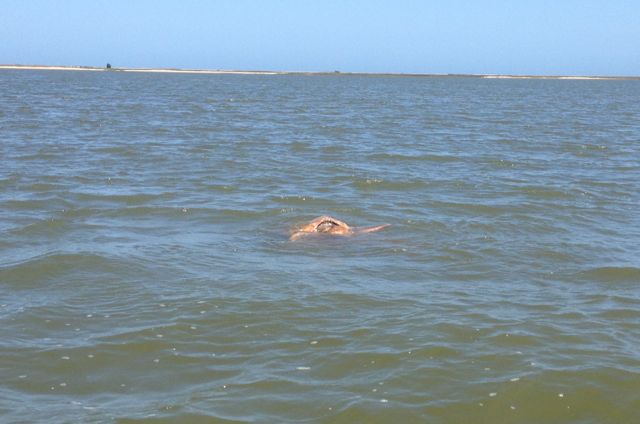
Mating loggerheads behind Cape Island May 2013
The Bay crossing was very smooth, allowing me to stand and observe all the way. There were no disturbances from other boats, since it was the Friday before Memorial Day weekend, and these waters would experience relative congestion. It was to be a negative tide (-.38), and even an hour and a half prior to the final ebb Bird Shoal appeared dimly to the north. I recalled my Walking across the Bay a few years ago. Halfway across, I passed a black skimmer on the opposite course, and in that moment another loggerhead rose to breathe. The wind was dying, but the push of the outgoing tide carried me on to the Northeast Point. In the last fifty yards, an ATV rounded the point coming in my direction, finishing up his patrol of the island searching for loggerhead nests. It was John Kiesling, completing a two day volunteer shift on Bull Island, and fresh from finding one nest that morning at the opposite end of the island. 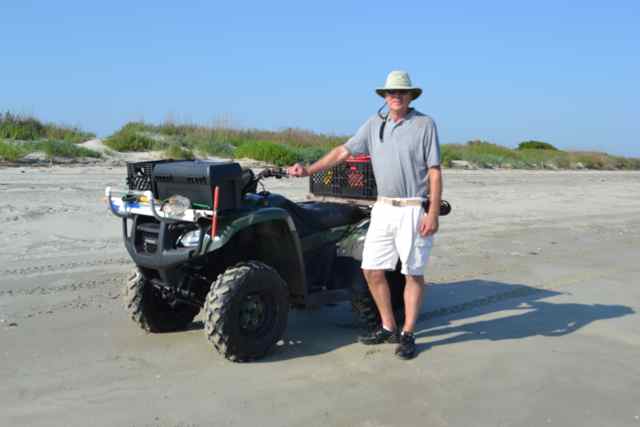 John and I have worked together for a number of years building the turtle hatcheries on Cape Island. We chatted for a few minutes, and he helped me drag Kingfisher up the beach to a safe height. John headed on to finish up, and I took a dip in the smooth inlet before beginning my walk to the Boneyard.
John and I have worked together for a number of years building the turtle hatcheries on Cape Island. We chatted for a few minutes, and he helped me drag Kingfisher up the beach to a safe height. John headed on to finish up, and I took a dip in the smooth inlet before beginning my walk to the Boneyard.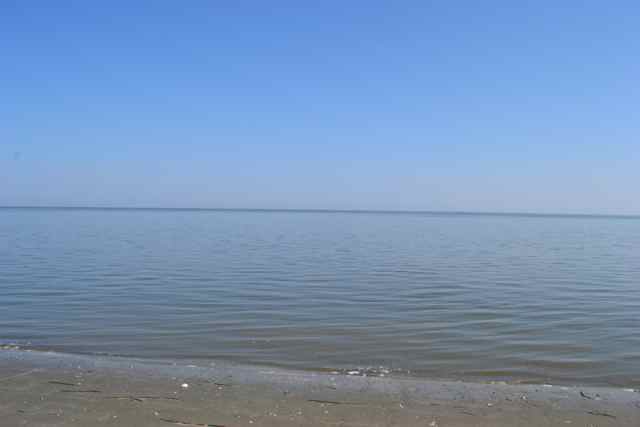
The Northeast Point had been rearranged again with a gully (now dry) running around the point and down the beach on the island’s eastern face. Ahead the beach was gullied and pooled by the remains of marsh sediments eroded out of the island’s sands. 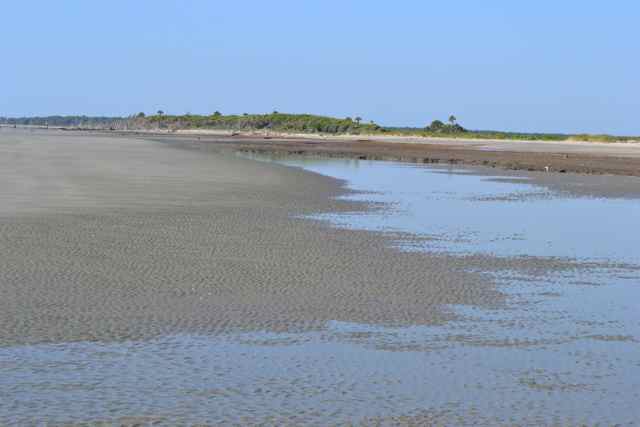 Beached cannonball jellyfish, food of marine turtles, were scattered along the strand.
Beached cannonball jellyfish, food of marine turtles, were scattered along the strand.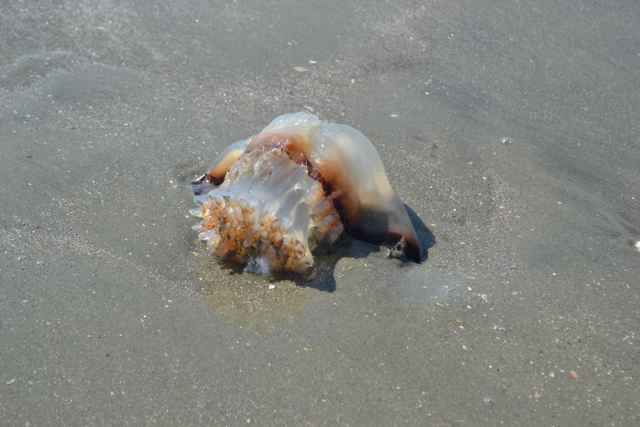 I stuck to the low tide line as I walked to the south seeking the low tide and the Boneyard. At the “Little” Boneyard, an assemblage of birds appeared at a typical low tide roost I have often described as the “Waiting Beach”: the group was dominated by royal terns, black skimmers, and brown pelicans. I took a path away from the birds on the way south.
I stuck to the low tide line as I walked to the south seeking the low tide and the Boneyard. At the “Little” Boneyard, an assemblage of birds appeared at a typical low tide roost I have often described as the “Waiting Beach”: the group was dominated by royal terns, black skimmers, and brown pelicans. I took a path away from the birds on the way south.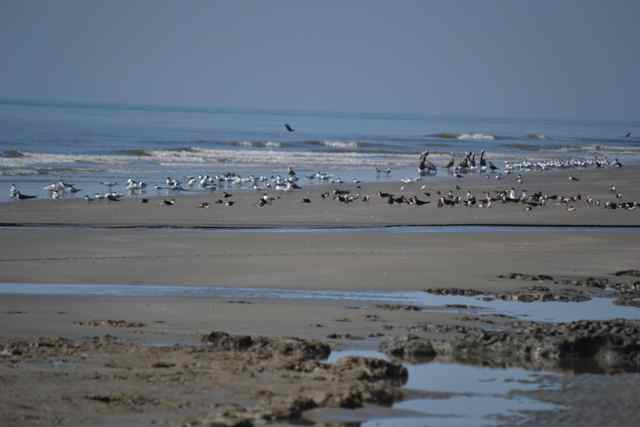
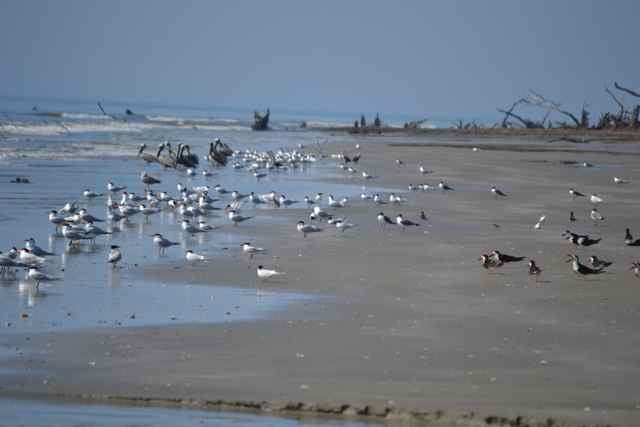
Before the Boneyard, ruddy turnstones explored the intertidal area. 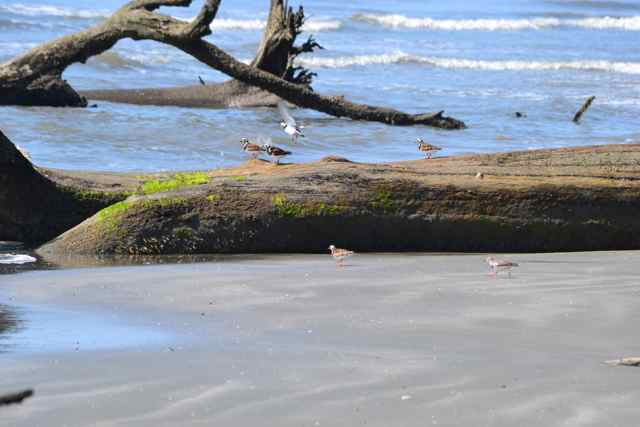 One of the signature trees at the Boneyard, still standing out in the surf at low tide, was more notable due to a bird of prey perched at the top.
One of the signature trees at the Boneyard, still standing out in the surf at low tide, was more notable due to a bird of prey perched at the top. 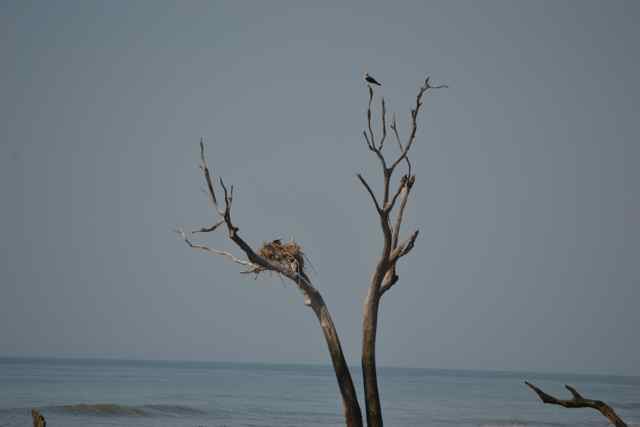 As I drew closer, a huge nest occupied by the other member of this osprey pair appeared. The perched bird flew off, and I gave the nest a wide berth as I marveled at this new nest, built since my last walk past here in February.
As I drew closer, a huge nest occupied by the other member of this osprey pair appeared. The perched bird flew off, and I gave the nest a wide berth as I marveled at this new nest, built since my last walk past here in February. 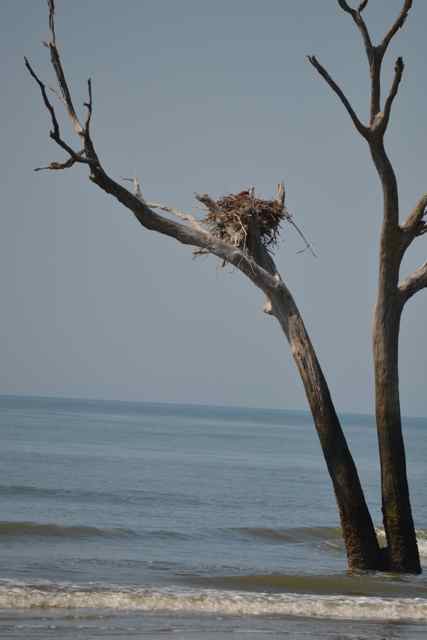 Stopping for a swim and lunch, I found my turnaround as the breeze was doing likewise. The wind was beginning to initiate its arrival from the south – a reversal as predicted.
Stopping for a swim and lunch, I found my turnaround as the breeze was doing likewise. The wind was beginning to initiate its arrival from the south – a reversal as predicted.
I ran into a couple off the ferry, and we chatted for a few minutes. This was their third trip to the island, and shelling was a primary pursuit. Seeing them again on my return walk, I asked about loggerhead sightings on the ride over (none), though they mentioned that the captain (Richard Stuhr) spotted a small shark (they didn’t). As if on cue, the dorsal and tail fin of a 3-4 foot shark appeared right along the beach in the small surf, and we all got a good look as this fish patrollied the edge looking for a meal. They wondered about the species, and I deferred the possibilities to their ferry captain, a retired professional fishing guide.
Continuing alone down the beach, I spotted a larger black fin twenty yards out, and without the distinctive movement of a dolphin. 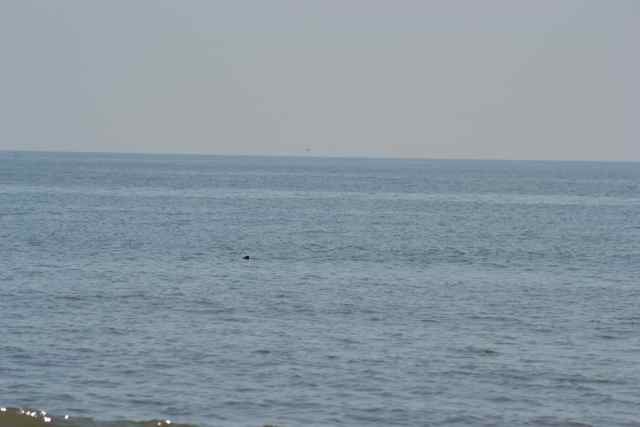
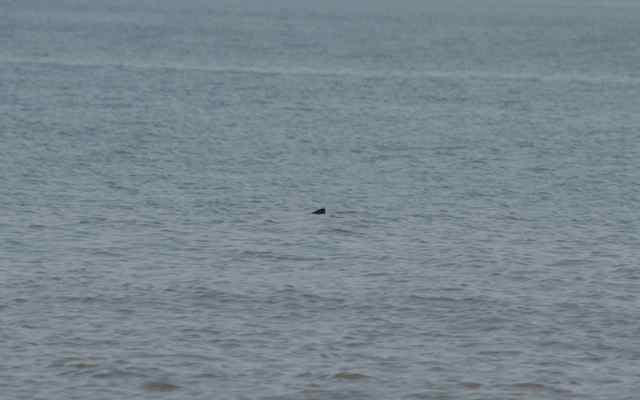 This larger shark continued to parallel my walk for the next thirty minutes toward the Northeast Point. Numerous shorebirds were feeding on invertebrates along the marsh remnants, accompanied by other seabirds including the diminutive least tern. As I came into the area of shoals near the Point I lost track of my shark companion. Upon arrival at Kingfisher the waters were coming up toward the hull, and I took advantage of the smooth waters to cool off prior to rigging and sailing off.
This larger shark continued to parallel my walk for the next thirty minutes toward the Northeast Point. Numerous shorebirds were feeding on invertebrates along the marsh remnants, accompanied by other seabirds including the diminutive least tern. As I came into the area of shoals near the Point I lost track of my shark companion. Upon arrival at Kingfisher the waters were coming up toward the hull, and I took advantage of the smooth waters to cool off prior to rigging and sailing off. 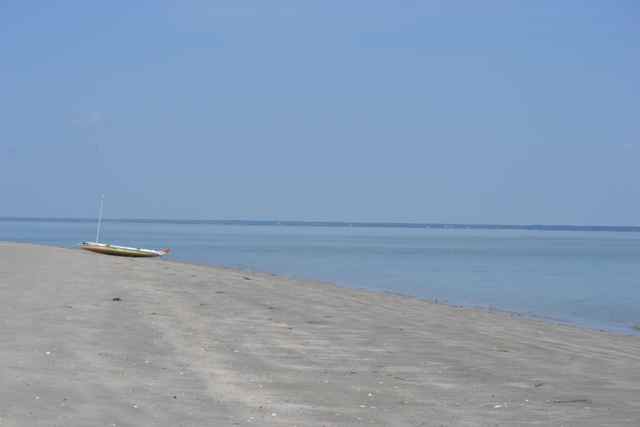 The south wind was solid on the ocean side, but had yet to fill the Bay. This wind coupled with the now incoming tide would provide us with the smoothest and easiest of sails back home.
The south wind was solid on the ocean side, but had yet to fill the Bay. This wind coupled with the now incoming tide would provide us with the smoothest and easiest of sails back home.
The conditions allowed for standing again, but I only came up with a couple of possible loggerhead sightings. We now had the company of other boats also getting an early start to the big weekend. The patchy quality of the wind gave way to a solid south wind before we left the Bay. Appearing over the marsh toward the mainland in the ICW were several masts of snowbirds heading north. They carried headsails as they motored north; we arrived at the ICW with the wind at our stern, completing our trip under the most favorable conditions.
P.S. Those shark fins caught several people’s attention, and in the comments below Richard Stuhr suggested the shark right along the beach was a bonnethead. I would agree, having seen quite a few working the edges of marsh banks and beaches in the past. He sent a photo of one, and it is posted below, with both the dorsal and tail fins exposed. Thanks Captain Stuhr!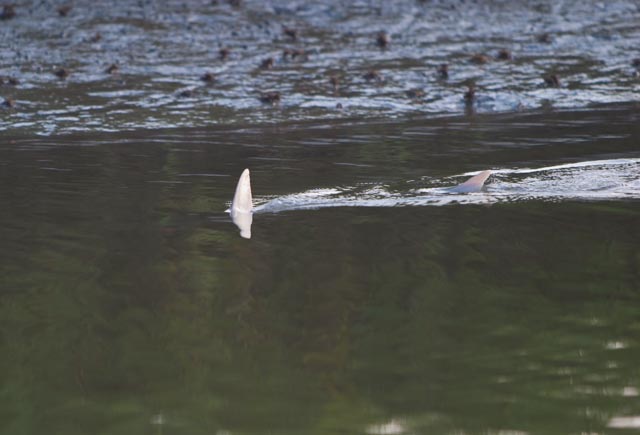
Sounds like a great sail! Didn’t know turtles eat jellyfish. And though you deferred identifying the shark — what is your guess as to the species?
The jellyfish menu is the issue with plastic garbage bags – the turtles mistake the bags for jellyfish, consume them, and possibly are killed by that consumption. A recent dead leatherback turtle found on Seabrook Island – a 900 lb one – appeared to have succumbed to problem.
I am going to ask Richard Stuhr if he will make an educated guess about the shark.
Bob,
I can’t say what the larger shark farther off the beach was but the smaller shark closer in may well have been a bonnethead. That is the shark I spotted from the ferry and tried to point out to the couple before it dissappeared. They move into the coastal creeks in summer in search of shrimp, crabs and small fish. You can see them cruising tight to the edges of the saltier creeks with their fins out the water. Their eyes are on stalks similar to a hammerhead but their heads are rounded between the eyes. I have heard them called “shovelheads” as well which refers to the rounded shape. The average size is only 2-3 feet but I have caught (and released) some larger.
FYI- SCDNR published “Sharks of South Carolina” by Charles H. Farmer
I believe it is free for the asking from SCDNR.
I probably overestimated that shark’s length – normal human behavior to do so, right? As a side story, the first fish my daughter caught on her 5th (or 6th) birthday on her new Fisher Price fishing pole was Jaws – a bonnethead.
And that other shark? It is nice to have some mysteries, and that fish will remain one.
Loved the post, and the wonder at the sudden appearance of the osprey nest. I took a video of a feeding bonnethead last summer, along with some photos: they’re here on the Dewees Island Blog:
http://deweesislandblog.com/2013/07/21/bonnethead-sharks/#sthash.B7lxXP5M.dpbs
Thanks for the link to the post and the bonnethead video, Judy. A major nursery for sharks is Bulls Bay, providing many young sharks for our Lowcountry waters. Time for a Bay cruise soon.
That is a gorgeous shot of the birds around the boneyard!
A birding Mecca out there.
Bob,
Bless you and the others that help keep the sea turtles going. I’d love to see one in the wild. Going to Myrtle Beach this September and don’t think I’ll see any around there? Maybe I can talk Debbie into another Bulls Island adventure?
Ron
Yes, much less chance of sea turtles around Myrtle Beach, but you never know. But get back to Cape Romain National Wildlife Refuge and you will see them – just a matter of time.
I love “little boneyoard” … This stretch of beach is my favorite in the world. The name Waiting Beach is perfect as this is where I wait at sunrise as the photographers photograph in “Big Boneyard” … The birding here is stunning. Thank you for keeping us connected with Cape Romain Salty One…and I love the input from Capt. Richard Stuhr. He is the finest kind. See you on the water! cc
I heard the term “Little Boneyard” initially from Tricia Midgett, so not coined by me. It is a most special stretch of beach for many reasons.
Perhaps you can inform readers about when the ospreys built that nest at the Boneyard – did you see it in progress?
Am jealous you have seen/saw loggerheads mating! We have encountered porpoises mating but not the loggerhead. Boy, talk about a precarious place to put a nest.. those birds sure picked a winner 🙂 but the tree has been there quite awhile so guess they will be safe.. they certainly have an unobstructed view of their surroundings. Have seen quite few osprey nests this year. G
It is clear to me that you are not spending enough time on your home waters since they are major mating areas. Think about retiring and making time, and you will see them.
mmmm…I thought I WAS retired!? g
Bob, I loved read this adventure and seeing the pics, especially the osprey nest in that lonely tree! When work settles down 🙂 I want to make a trip out to Bulls Bay. Happy sailing!
The Boneyard is always spectacular – the new nest only enhances the scene.
You tell them to settle that work scene down, and get out here soon.